Pet insurance system and method
Marshall , et al.
U.S. patent number 10,255,993 [Application Number 16/115,446] was granted by the patent office on 2019-04-09 for pet insurance system and method. This patent grant is currently assigned to Trupanion, Inc.. The grantee listed for this patent is Trupanion, Inc.. Invention is credited to Chris Cappelletti, Kerri E. Marshall, Katie Plowman, Darryl Rawlings.

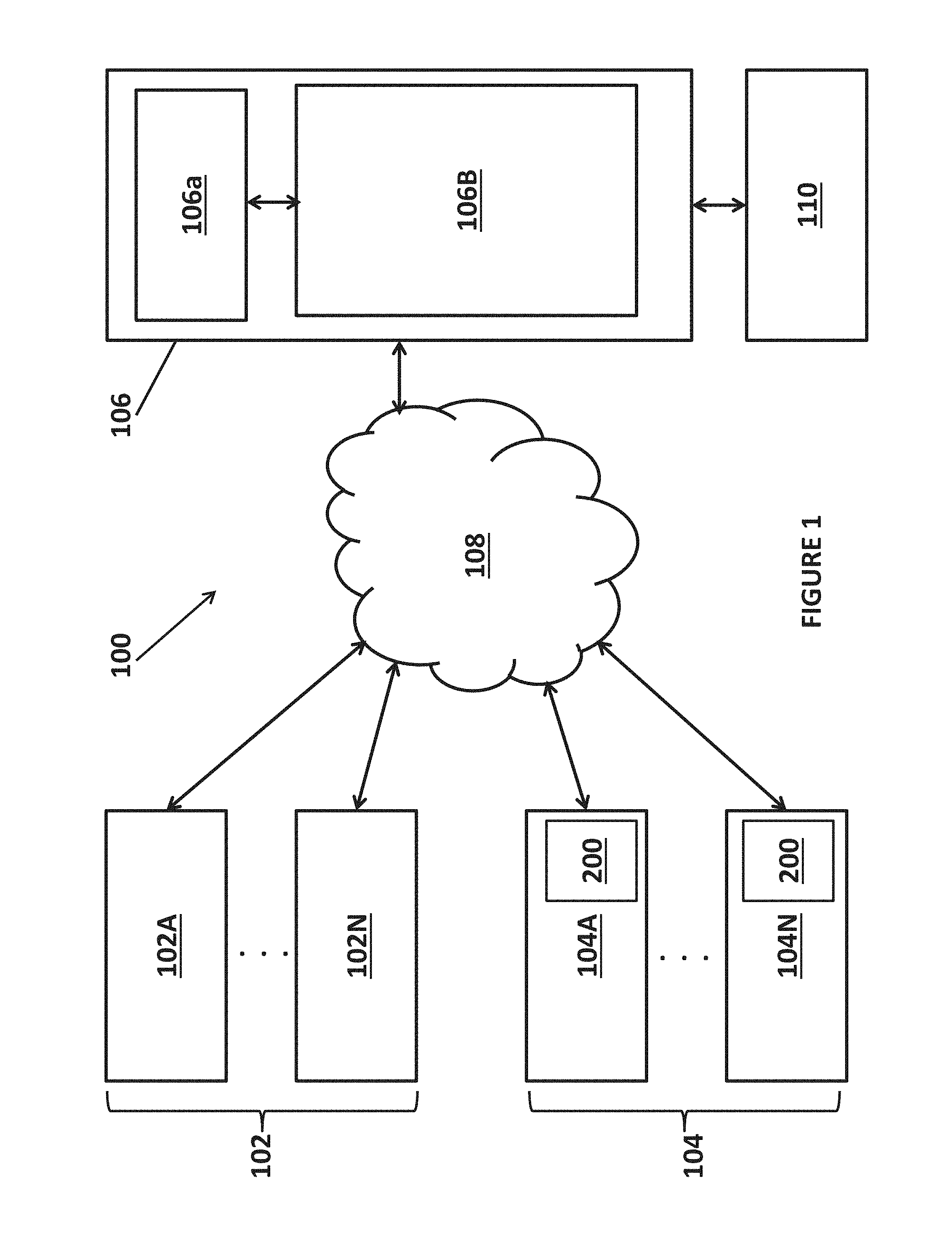
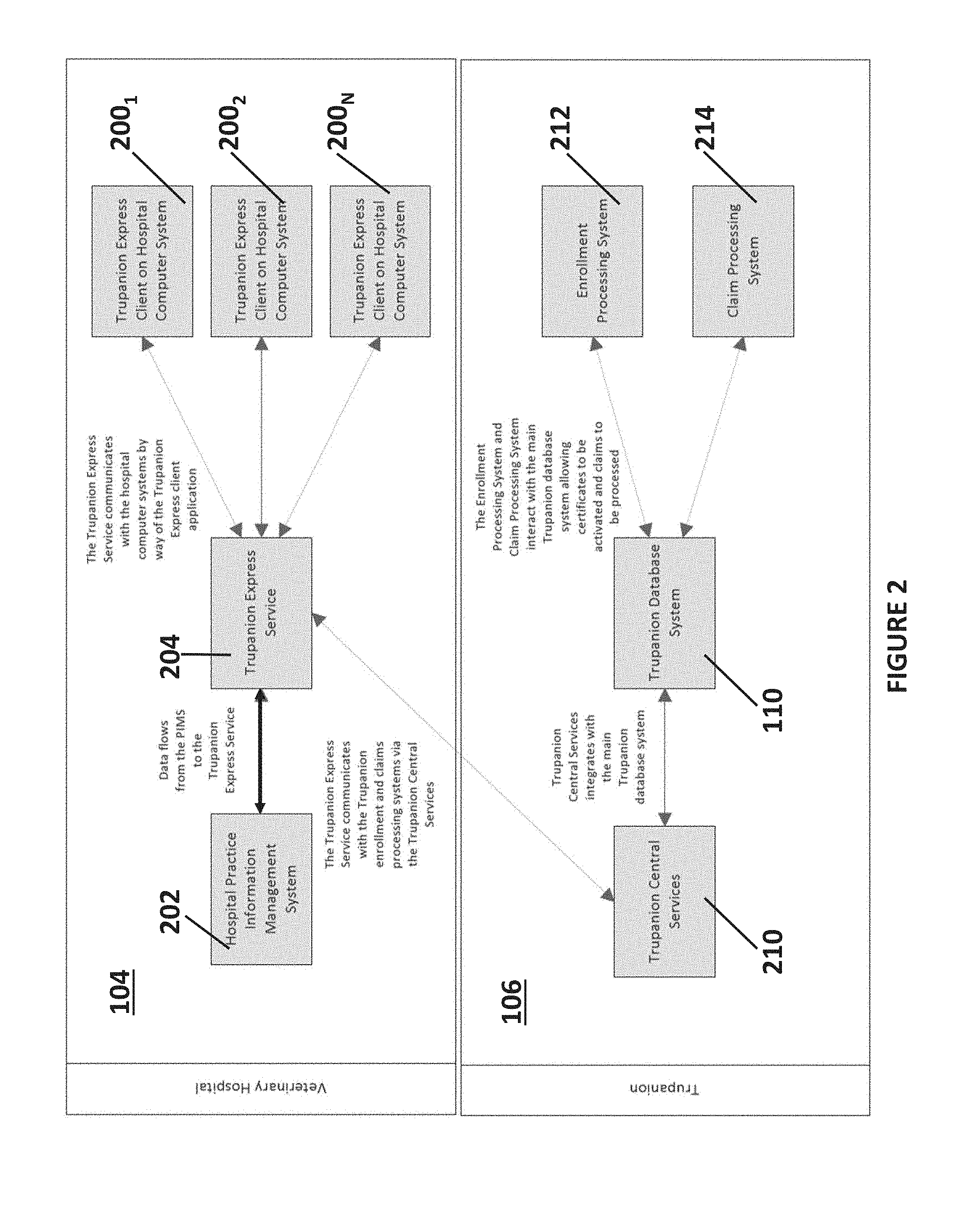


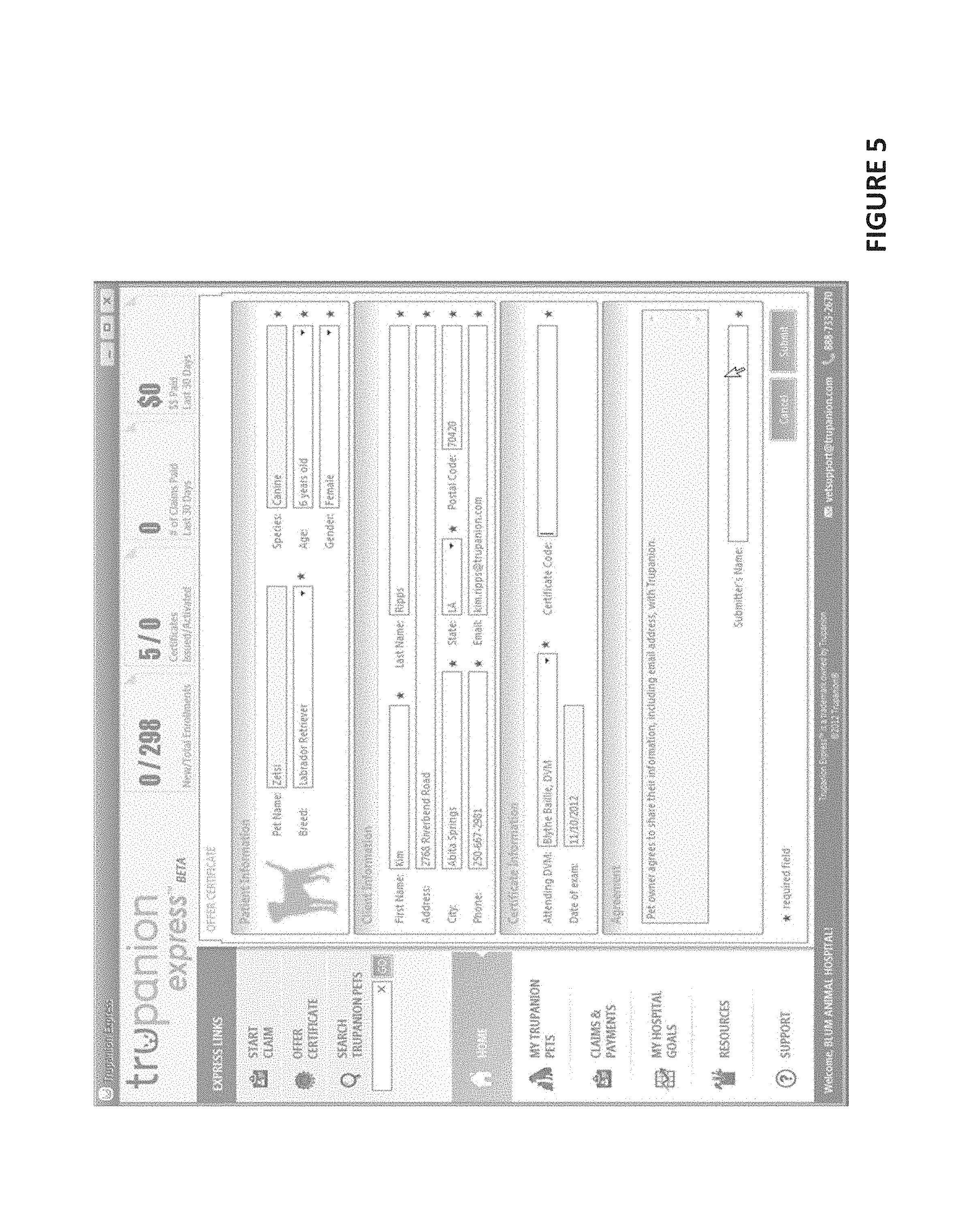
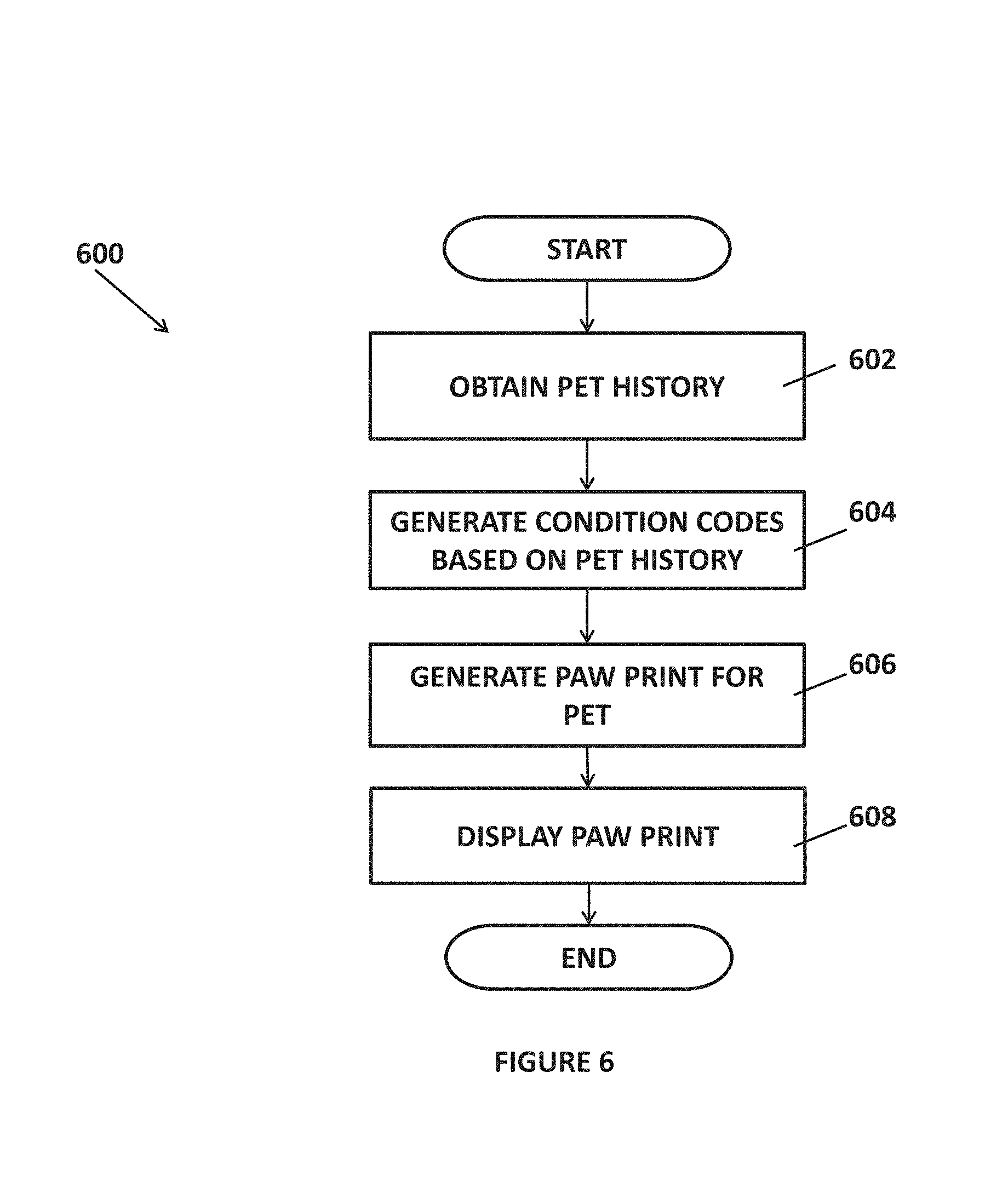


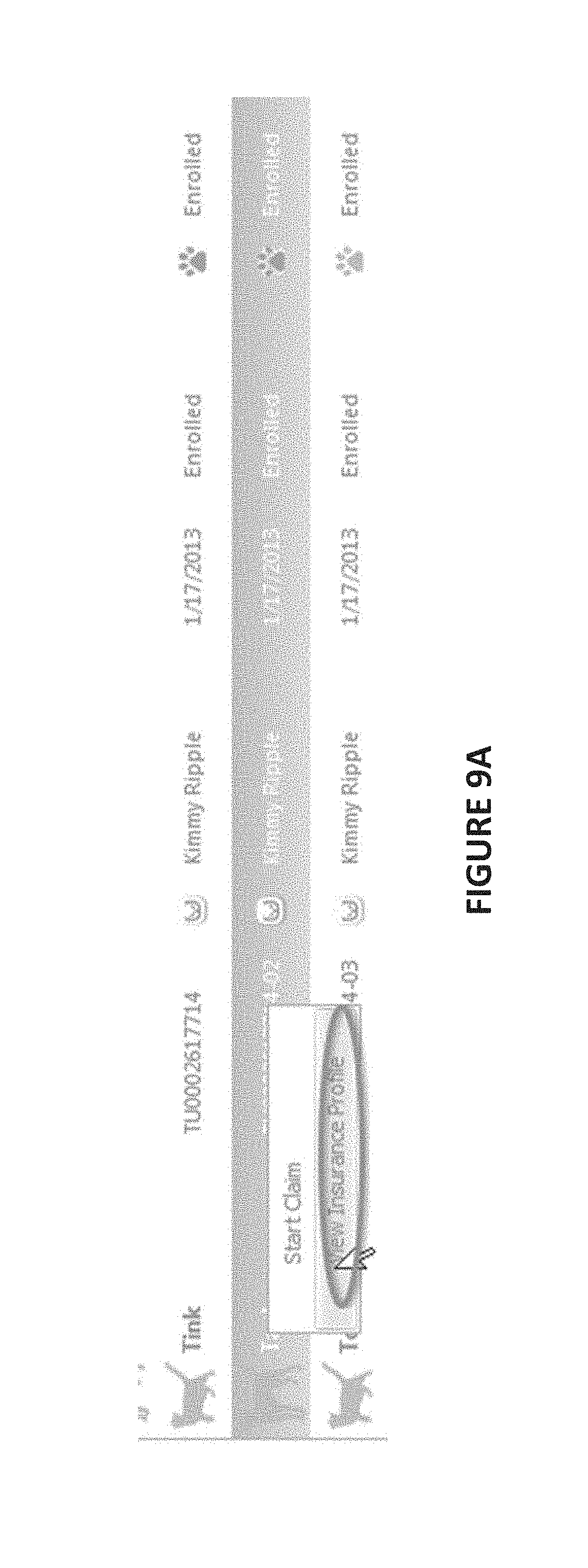
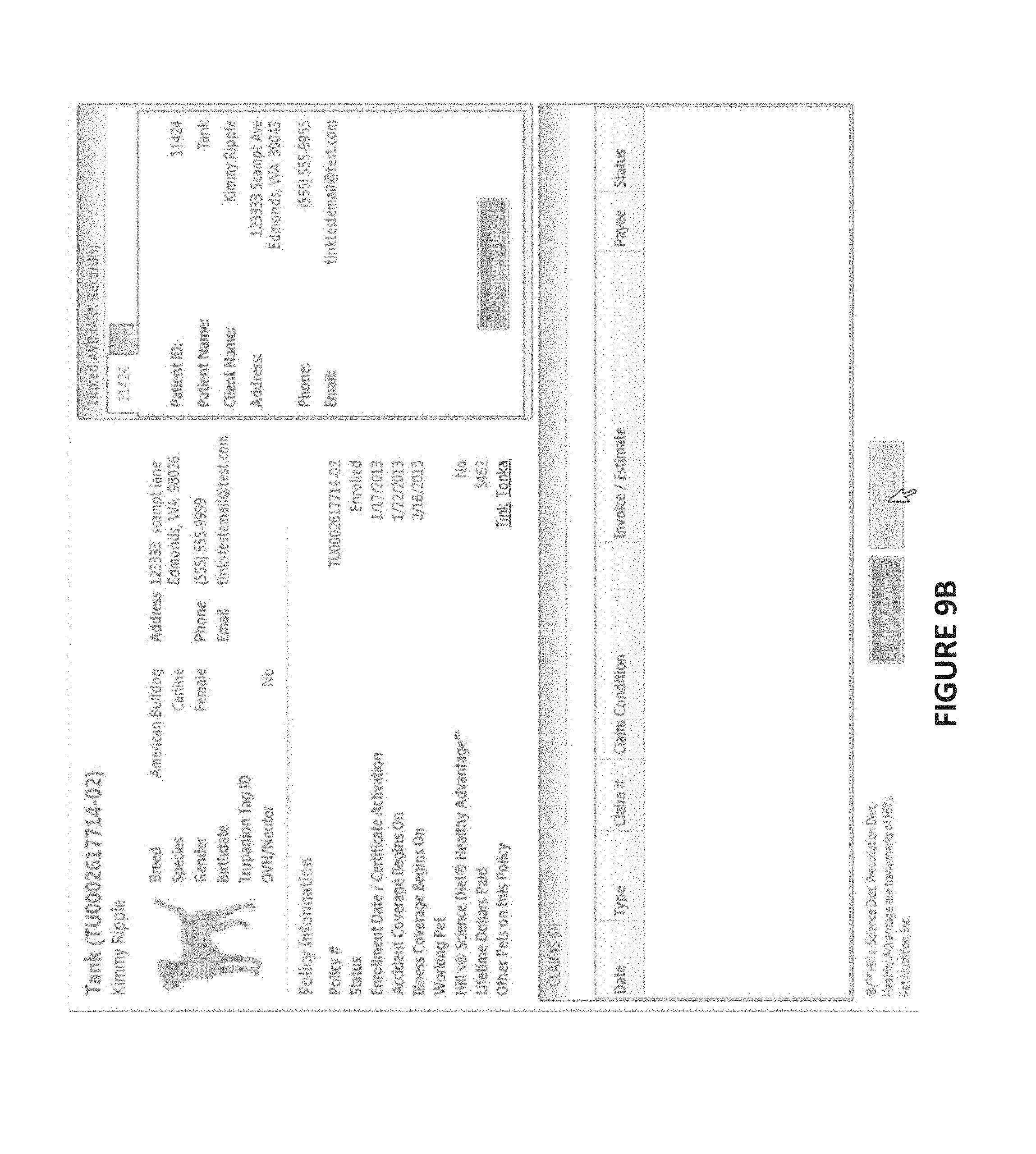

View All Diagrams
| United States Patent | 10,255,993 |
| Marshall , et al. | April 9, 2019 |
Pet insurance system and method
Abstract
A pet insurance system and method are provided. The pet insurance system provides rapid insurance enrollment and quick claim processing. In addition, the pet insurance system and method generates a pet health status identifier that is displayed to users of the system.
| Inventors: | Marshall; Kerri E. (Seattle, WA), Rawlings; Darryl (Seattle, WA), Plowman; Katie (Seattle, WA), Cappelletti; Chris (Carnation, WA) | ||||||||||
|---|---|---|---|---|---|---|---|---|---|---|---|
| Applicant: |
|
||||||||||
| Assignee: | Trupanion, Inc. (Seattle,
WA) |
||||||||||
| Family ID: | 51531934 | ||||||||||
| Appl. No.: | 16/115,446 | ||||||||||
| Filed: | August 28, 2018 |
Prior Publication Data
| Document Identifier | Publication Date | |
|---|---|---|
| US 20180374574 A1 | Dec 27, 2018 | |
Related U.S. Patent Documents
| Application Number | Filing Date | Patent Number | Issue Date | ||
|---|---|---|---|---|---|
| 14210079 | Mar 13, 2014 | ||||
| 61801404 | Mar 15, 2013 | ||||
| Current U.S. Class: | 1/1 |
| Current CPC Class: | G16H 40/20 (20180101); G06Q 10/10 (20130101); G06Q 40/08 (20130101); G06F 19/328 (20130101) |
| Current International Class: | G16H 40/20 (20180101); G06Q 10/10 (20120101); G06Q 40/08 (20120101) |
| Field of Search: | ;705/4 |
References Cited [Referenced By]
U.S. Patent Documents
| 5720502 | February 1998 | Cain |
| 6117526 | September 2000 | Marks |
| 6966064 | November 2005 | Schneidewend et al. |
| 7155405 | December 2006 | Petrovich |
| 7266770 | September 2007 | Onbe et al. |
| D572717 | July 2008 | Loehr et al. |
| 7496583 | February 2009 | Moore et al. |
| D605653 | December 2009 | Danton |
| 8341547 | December 2012 | Ingman et al. |
| 8359605 | January 2013 | Ross |
| D777737 | January 2017 | Marshall et al. |
| 1001353 | July 2018 | Marshall et al. |
| 2003/0004740 | January 2003 | Dickey et al. |
| 2004/0254816 | December 2004 | Myers |
| 2005/0060344 | March 2005 | Pawlick |
| 2005/0091606 | April 2005 | Sauermann |
| 2006/0074724 | April 2006 | Schwartz |
| 2006/0075724 | April 2006 | Kammler et al. |
| 2006/0196436 | September 2006 | Nichols |
| 2006/0251775 | November 2006 | Anderson et al. |
| 2007/0084099 | April 2007 | Sarbo et al. |
| 2007/0203758 | August 2007 | Stephens |
| 2008/0172617 | July 2008 | Takeda et al. |
| 2008/0307339 | December 2008 | Boro et al. |
| 2009/0106678 | April 2009 | Chase et al. |
| 2009/0182586 | July 2009 | Cohane |
| 2009/0289844 | November 2009 | Palsgrove et al. |
| 2009/0300540 | December 2009 | Russell |
| 2010/0017234 | January 2010 | Stephens et al. |
| 2010/0293487 | November 2010 | Schoenberg |
| 2011/0131507 | June 2011 | Butcher |
| 2012/0060105 | March 2012 | Brown et al. |
| 2012/0110453 | May 2012 | Ma et al. |
| 2012/0265702 | October 2012 | Maher |
| 2013/0218592 | August 2013 | Hashmat |
| 2014/0155785 | June 2014 | Haas |
| 2014/0278551 | September 2014 | Marshall et al. |
| 2002073802 | Mar 2002 | JP | |||
| 2013022984 | Feb 2013 | JP | |||
| WO-2006036316 | Apr 2006 | WO | |||
| WO-2014152179 | Sep 2014 | WO | |||
| WO-2017075207 | May 2017 | WO | |||
Other References
|
Co-pending U.S. Appl. No. 16/023,624, filed Jun. 29, 2018. cited by applicant . European search report dated Dec. 9, 2016 for EP Application No. 14770490. cited by applicant . International search report with written opinion dated Nov. 29, 2016 for PCT/US2016/059095. cited by applicant . Notice of allowance dated May 17, 2018 for U.S. Appl. No. 14/924,606. cited by applicant . Notice of allowance dated May 29, 2018 for U.S. Appl. No. 14/924,606. cited by applicant . PCT/US2014/27042 International Search Report and Written Opinion dated Oct. 1, 2014. cited by applicant . U.S. Appl. No. 14/210,079 Final Office Action dated Sep. 5, 2017. cited by applicant . U.S. Appl. No. 14/210,079 Non-Final Office Action dated Dec. 7, 2016. cited by applicant . U.S. Appl. No. 14/210,079 Non-Final Office Action dated Mar. 21, 2018. cited by applicant . U.S. Appl. No. 14/924,606 Final Office Action dated Jul. 22, 2016. cited by applicant . U.S. Appl. No. 14/924,606 Final Office Action dated Oct. 12, 2017. cited by applicant . U.S. Appl. No. 14/924,606 Non-Final Office Action dated Jan. 12, 2017. cited by applicant . U.S. Appl. No. 14/924,606 Non-Final Office Action dated Mar. 10, 2016. cited by applicant . U.S. Appl. No. 29/449,619 Final Office Action dated Jul. 17, 2015. cited by applicant . U.S. Appl. No. 29/449,619 Non-Final Office Action dated Oct. 3, 2014. cited by applicant . U.S. Appl. No. 29/449,619 Notice of Allowance dated Sep. 13, 2016. cited by applicant. |
Primary Examiner: Reyes; Reginald R
Attorney, Agent or Firm: Wilson Sonsini Goodrich & Rosati
Parent Case Text
PRIORITY CLAIMS/RELATED APPLICATIONS
This application is a continuation application of U.S. application Ser. No. 14/210,079, filed Mar. 13, 2014, which claims priority to and the benefit under 35 USC 119(e) and 120 of U.S. Application No. 61/801,404, filed on Mar. 15, 2013 and entitled "PET INSURANCE SYSTEM AND METHOD", the entire contents of each are incorporated herein by reference.
Claims
The invention claimed is:
1. A pet medical insurance system, comprising: a backend component comprising a database system; one or more user computing devices coupled to the backend component over a communication path, each user computing device being configured for use by an owner of a patient and having a processor, memory and a plurality of lines of computer code; a computer system at a veterinary practice connected to the backend component over the communication path, the computer system comprising: a processor; memory; and a first practice information management system of the veterinary practice having one or more modules for managing the veterinary practice; and a client being in communication with the first practice information management system; a plug-and-play express system connected to the first practice information management system of the computer system and configured for electronic communication with the backend component, wherein the plug-and-play express system retrieves data from the first practice information management system, maps the data according to the database system of the backend component and sends the mapped data to the backend component, thereby limiting the data traffic between the backend component and the first practice information management system, the plug-and-play express system being plug-and-play integratable with a second or more different practice information management systems for connection thereto; the backend component comprising: a processor, memory, and a plurality of lines of computer code configured to: communicate with the plug-and-play express system to request data from the first practice information management system, the plug-and-play express system accessing data from the first practice information management system of each veterinary practice, retrieve via the plug-and-play express system one or more pieces of data about a patient from the first practice information management system, and store the one or more pieces of data about the patient; each of the one or more user computing devices further configured to: communicate with the backend component to request insurance coverage for a particular patient, and receive an insurance offer from the backend component and allow activation of the insurance offer; and the backend component further configured to: receive the request for insurance coverage for the patient, generate an insurance coverage for the patient that is stored in the database when the insurance offer has been activated, and communicate the insurance coverage for the patient to the veterinary practice computer system through the plug-and-play express system; the veterinary practice computer system further configured to display the communicated insurance coverage as a patient insurance coverage status to the veterinary practice; and the backend component further configured to: programmatically process a claim for one or more treatments and procedures for the particular patient based on the insurance coverage status of the patient, and electronically pay an amount to the veterinary practice for the one or more provided treatments and procedures at the time of completion of the one or more provided treatments and procedures.
2. The system of claim 1, wherein the backend component further comprises a user interface component that is configured to generate a user interface containing information about the patient for the veterinary practice.
3. The system of claim 1, wherein the database of the backend component further stores one or more pieces of data about one or more of treatments and procedures for the patient.
4. The system of claim 2, wherein the user interface component is configured to generate an insurance claim form.
5. The system of claim 1, wherein the backend component further comprises one or more computing resources that host the backend component.
6. The system of claim 5, wherein each of the one or more computing resources is one of a server computer and/or cloud computing resource(s).
7. A method of providing insurance for veterinary treatments or veterinary procedures using a backend component implemented on a computer, comprising: receiving, by a services component of the backend component from an insurance component used by a veterinary practice that is remote from the backend component, one or more pieces of data about an animal; storing the one or more pieces of data about the animal in a database of the backend component; generating, on one or more computing devices capable of being coupled to the backend component, a request for insurance coverage for the animal; receiving, on the one or more computing devices capable of being coupled to the backend component, an insurance offer from the backend component; mapping data from a first practice information management system of the veterinary practice to the insurance component by a plug-and-play express system connected to the first practice system and in communication with the backend component, the plug-and-play express system: receiving data from the first information management practice system; mapping the data according to the insurance component; and sending the mapped data to the insurance component, thereby limiting the data traffic between the insurance component and the first practice information management system to create efficient correspondence between the insurance component and the practice system and improve the enrollment and claim processing of the animal, the plug-and-play express system being plug-and-play integratable with a second or more practice information management systems for connection thereto; enrolling, by an enrollment processing component, the owner of the animal for insurance for the animal upon receipt of the request for the insurance of the animal and issuing the insurance offer for the animal; programmatically generating, using a claims processing component of the backend component, an eligibility of insurance coverage for the animal when the insurance has been activated by the owner, the eligibility of insurance coverage being stored in the database; displaying, the eligibility of insurance coverage status for the animal at the veterinary practice; and programmatically processing, using the claims processing component of the backend component, a claim for a treatment or procedure for the animal, wherein the claim is processed based on the eligibility of insurance coverage status of the animal and paying an amount to the veterinary practice for the treatments or procedures.
8. The method of claim 7, further comprising generating a user interface containing information about the animal.
9. The method of claim 7, further comprising storing the one or more pieces of data about the animal.
10. The method of claim 8, further comprising generating an insurance claim form.
11. The method of claim 7, wherein enrolling the owner of the animal further comprises activating the offer for insurance coverage.
12. A pet insurance system, comprising: a first veterinary practice information management system of a veterinary practice having an insurance component; a backend component remote from the first veterinary practice information management comprising a processor, a memory, a database and a plurality of lines of computer code that when executed by the processor causes the backend component to: communicate with the insurance component used by the first veterinary practice information management system over a communications path, receive from the insurance component over the communications path, one or more pieces of data about an animal and store the one or more pieces of data about the animal in the database; one or more user computing devices capable of being coupled to the backend component, each computing device comprising a processor, a memory and a plurality of lines of computer code that when executed by the processor causes the one or more user computing devices to: communicate with the backend component to request insurance coverage for the animal and receive an insurance offer from the backend component; a computing device at the veterinary practice having a processor, memory and a plurality of lines of computer code in an express system configured to: connect to the first veterinary practice information management system of the veterinary practice and communicate between the first veterinary practice information management system and the backend component; the backend component further configured to receive the insurance coverage request for the animal, generate the insurance offer, generate an eligibility of insurance coverage for the animal when the insurance has been activated and displayed at the veterinary practice as patient insurance coverage status and displayed at the user computing device as patient insurance coverage status, programmatically process a claim for one or more treatments or procedures for the animal based on the eligibility of insurance coverage status of the animal and pay an approved claim amount to the veterinary practice for the one or more provided treatments and procedures; a plug-and-play express system connected to the first veterinary practice information management system of the veterinary practice and configured to communicate with the backend component, the plug-and-play express system configured to receive data from the veterinary practice information management system, map the data according to the insurance component of the backend component and send the mapped data to the backend component, thereby limiting the data traffic between the backend component and the first veterinary practice information management system, the plug-and-play express system being plug-and-play integratable with a second or more different veterinary practice information management systems of the veterinary practice for connection thereto.
13. The system of claim 12, wherein the backend component further comprises a user interface component that is configured to generate a user interface containing information about the animal for the veterinary practice.
14. The system of claim 12, wherein the backend component is configured to generate an insurance claim.
15. The system of claim 13, wherein the user interface component is configured to generate an insurance claim.
16. The system of claim 12, wherein the backend component further comprises one or more computing resources that host the backend component.
17. The system of claim 16, wherein each of the one or more computing resources is one of a server computer and/or cloud computing resource(s).
18. The system of claim 12, wherein the one or more user computing devices are configured to allow the owner of the particular animal to activate insurance coverage.
19. The system of claim 18, wherein the one or more user computing devices further comprise a browser application executed by the processor to interact with the backend component.
Description
FIELD
The disclosure relates generally to a pet insurance system and method.
BACKGROUND
Pet insurance has existed for a very long time since pets often have health problems that require major surgeries, treatment and the like. However, most current pet insurance systems are very cumbersome and do not allow a pet owner to rapidly obtain the insurance. Furthermore, most of the existing systems do not provide a veterinarian or pet hospital with an easy to view status of any particular pet so that the veterinary may not know, at the time of a major surgery or treatment, if the pet is going to be covered by insurance which would be desirable. In addition, most existing pet insurance systems take so long to process a claim that both the pet owner and the veterinarian or pet hospital are unhappy with the delay.
Thus, it is desirable to provide a pet insurance system and method that overcomes the above limitations and it is to this end that the disclosure is directed.
BRIEF DESCRIPTION OF THE DRAWINGS
FIG. 1 is a diagram of an implementation of a pet insurance system;
FIG. 2 illustrates more details of the pet insurance system;
FIG. 3 illustrates an example of a user interface of the pet insurance system;
FIG. 4 illustrates a method for obtaining insurance and certificate tracking using the pet insurance system;
FIG. 5 illustrates an example of a user interface for offering a pet insurance certificate to a pet owner;
FIG. 6 illustrates a method for determining and displaying a status of a pet to users of the pet insurance system;
FIG. 7 illustrates an example of a user interface of the pet insurance system that displays a status of each pet;
FIG. 8 illustrates an example of a user interface that displays a set of details of the status of a pet;
FIGS. 9A and 9B illustrates examples of user interfaces to view an insurance profile of a pet;
FIG. 10 illustrates a method for submitting and processing a claim in the pet insurance system;
FIG. 11 illustrates an example of a user interface of submitting a claim in the pet insurance system;
FIG. 12 illustrates an example of a claims form in the pet insurance system;
FIG. 13 illustrates an example of a claims submission user interface of the pet insurance system; and
FIGS. 14A and 14B are examples of a new claims and claim payment user interface of the pet insurance system.
DETAILED DESCRIPTION OF ONE OR MORE EMBODIMENTS
The disclosure is particularly applicable to a client server architecture pet insurance system and it is in this context that the disclosure will be described. It will be appreciated, however, that the system and method has greater utility.
FIG. 1 is a diagram of an implementation of a pet insurance system 100. The implementation in FIG. 1 is a typical client/server architecture that is described below in more detail. However, the system may also be implemented in a cloud computing architecture, a mainframe architecture, a software as a service mode and the like that are all which are within scope of this disclosure. The system may include one or more computing devices 102, such as 102A, . . . , 102N, and each computing device 102 may be used by a pet owner to connect to and interact with a pet insurance backend component 106 over a communications path 108. The system may also have one or more computing devices 104, such as 104A, . . . , 104N, and each computing device 104 may be used (or integrated into) a veterinary practice or pet hospital and allow the veterinary practice or pet hospital to connect to and interact with a pet insurance backend component 106 over a communications path 108. Each computing device 102, 104 may be a processor based device with storage, memory, a display and wireless or wired connectivity circuits that allow the computing device 102, 104 to interact with the backend component 106. For example, each computing device may be a smartphone device, such as a device operating using the iOS, Android or Symbian operating systems, a personal computer, a client server system, a terminal, a tablet computer, a cellular phone and any other device that would be capable of interacting with the backend component 106. In one implementation, each of the computing device 104 may have a client 200 that interacts with the backend component. In one implementation, the client or browser 200 may be a plurality of lines of computer code executed by the processor of the computing device. In one implementation, each of the computing device 102 may have a browser that interacts with the backend component, displays web pages and allows the user to enter information into forms. In one implementation, the browser may be a plurality of lines of computer code executed by the processor of the computing device 102.
The communication path 108 may be a wired or wireless network that may be unsecure or secure and uses typical protocols for the exchange of data between the computing devices 102, 104 and the backend component 106. For example, the communication path 108 may be an Ethernet network, the Internet, a wireless cellular network, a wireless digital data network and the like and the system is not limited to any particular communication path 108. In the implementation in which the communication path 108 is the Internet, the communication path 108 may use the known HTTP or HTTPS protocol for data communications.
The backend component 106 may be implemented as one or more computing resources or hardware devices. In one implementation, the backend component 106 may be one or more server computers, one or more cloud computing resources and the like and each resource has one or more processors, memory, persistent storage and the like. The backend component 106 may further comprise a web server 106a, a pet insurance management component 106B and a storage device 110 that are coupled together as shown in FIG. 1. The web server 106a, that may be implemented as a hardware web server or a software implemented web server, may generate and exchange web pages with each computing device 102 and exchange data with each computing device 102 that is using a browser. The pet insurance management component 106B manages the pet insurance system operations, including enrollment of pet owners, generation and maintenance of a status of each pet in the system, payment and processing of claims from the pet owners and interactions with the veterinary practice or pet hospital. The pet insurance management component 106B may be implemented as a plurality of lines of computer code that are stored in the computing resources and then executed by the processor(s) of the computing resources to implement the pet insurance management functions that are described below in more detail. The storage device 110 may be a hardware storage device or a software implemented storage device such as a database, that stores user and veterinary practice or pet hospital information for the system, stores information about each pet that is enrolled in the pet insurance system and stores the information about each pet insurance claim in the system.
FIG. 2 illustrates more details of the pet insurance system and in particular the components in each veterinary practice or pet hospital computing device 104 and the backend component 106 and the interactions between the two. As shown, the veterinary practice or pet hospital may have one or more clients 200, a hospital information management system 202 and a pet insurance component 204. As shown, data from the hospital information management system 202 flow into the pet insurance component 204 and the pet insurance component 204 connects to and communicates with the backend component 106 (specifically an enrollment system and a claims processing system) and the pet insurance component 204 connects to and communicates with the one or more clients 200 in the computing devices 104. In one implementation, each of the components of the veterinary practice or pet hospital computing device 104 may be a plurality of lines of computer code that are executed by a processor of the computing device 104. The Hospital Practice Information Management System (PIMS) is an existing system used by a veterinary practice or pet hospital that use database and visualization technologies (user interface) with the aim to support various hospital/patient management and administration tasks. Different PIMS manufacturers include different modules that allow for many common hospital technology requirements that may include inventory tracking, procedure codes, connection to diagnostic equipment and service providers, connection to a variety of radiology modalities and services and invoice generation.
The pet insurance component 204 may be provided by the pet insurance backend system 106 and may be installed in the computing device 104 of the veterinary practice or pet hospital. The pet insurance component 204, that may be known as the Trupanion Express service (TES), is a system which integrates with these varied systems to provide added value and operational simplicity for both veterinarians and pets. The service component of TES is responsible for retrieving and mapping data from any PIMS, communicating with Trupanion Central Services (TCS) 210 about claims or certificates and communicating with Trupanion Express Client (TREX) 200. TES 204 employs various technological mechanisms to reduce the amount of traffic between TCS and TREX, as well as the PIMS creating efficient correspondence. TES 204 may include an abstracted engine that allows communication with various PIMS systems on market today, as well as the ability to integrate with more in the future in a plug-and-play fashion.
The client 200, that may be known as Trupanion Express Client (TREX), is the user interface for Trupanion Express. It communicates with TES 204 with the aim to exchange information between the hospital and the backend component 106. The client allows submitting claims, issuing certificates, searching PIMS data for pet insurance clients and appointments, mapping clients between systems, and displaying all of the information for these activities in a digestible way for hospital staff. Additionally, TREX 200 is a catalyst for better workflows and communications for hospital staff--resulting in significantly improved patient care.
The backend component 106 may further comprise a services component 210, that may be known as Trupanion Central Services, the storage device 110, known as Trupanion database system, an enrollment processing system 212 and a claim processing system 214 that are coupled to each other as shown in FIG. 2. Sample data is included in the below table:
TABLE-US-00001 Sample Data Exchanged Between the Hospital & Enrollment Claims Trupanion Sample Data Sample Data Patient Demographics Policy ID & Type Claim Basics Client Demographics Policy Status Claiming Clinic Claim Form Enrollment Clinic Information Information Information Claim Outcomes & Invoices/Estimates Policy Coverage Amount Covered Medical Record Details Information Certificates Status
In one implementation, each of the components of the backend component 106 may be a plurality of lines of computer code that are executed by a processor of the computing device 106. The services component 210 integrated with the storage device. The enrollment processing system 212 and a claim processing system 214 may interact with the storage 110 allowing certificates to be issued and activated and claims to be processed. The services component 210 is a service inside Trupanion's network that receives TES requests and passes the appropriately-formed requests on to the Trupanion Database System (TruDat) 110. The Trupanion Database System (TruDat) is any location where transactional data for Trupanion's various IT systems is stored. The Enrollment Processing System is the system that issues certificates to pet owners interested in potentially becoming a Trupanion policyholder and the claim Processing System (PO) is the system that catalogs the collection of medical records that enables claims adjudicators to manage and process pet owner claims. Trupanion Express is revolutionary in that one of its purposes is to allow claims to be adjudicated very quickly--allowing the pet owner to not pay out-of-pocket expenses at the veterinary hospital. Said another way, Trupanion Express allows Trupanion to pay veterinarians directly with PO while the customer is standing at checkout, similar to the concept of a "co-pay" in human health care. Trupanion Express allows for near real time claims submission and claims processing enabling claim adjudication at point of sale at the veterinary clinic. Versus typical channels such as fax or mail that support a delayed reimbursement model for veterinary practices or pet hospitals and/or pet owners. For additional details, see Claim A.
FIG. 3 illustrates an example of a user interface 300 of the pet insurance system. The user interface may include a status bar 302 that shows statistics about the system (enrollments, certificates, claims and claims paid), a pet status portion 304 for each pet that is part of the pet insurance system and a navigation portion 306 that allows the user to navigate around the pet insurance system. The user interface may have are area 308 for each pet wherein that area further has start claim button 310 that allows the pet hospital to start an insurance claim on behalf of the pet owner for the particular pet and a status indicator 312, known as a Paw Print, that indicates a status of the pet within the pet insurance system. The generation of the Paw Print and the information that it conveys is described below in more detail.
FIG. 4 illustrates a method 400 for obtaining insurance and certificate tracking using the pet insurance system and FIG. 5 illustrates an example of a user interface for offering a pet insurance certificate to a pet owner. The pet insurance system makes it easier for a pet owner to get pet insurance (assuming no pre-existing conditions that prevent it) and then quickly be able to have proof of the pet insurance in the form of a certificate that can be presented to the veterinary practice or pet hospital to establish the insurance of the pet. In the method, a doctor may offer a pet owner a certificate (402) for pet insurance for a particular pet through the express service component 204. When the doctor offers the insurance to the pet owner, a person at the veterinary practice or pet hospital may enter the certificate into the client 200 and the information about the certificate (such as shown in FIG. 5) is passed onto the backend component 106 through the Trupanion express service 204. The pet owner, using a computing device 102 may then activate the certificate (and obtain pet insurance) using an email link of by phone which is sent to the backend component 204. Once the pet owner activates the certificate, the pet owner receives the certificate of insurance which is also passed back to the veterinary practice or pet hospital through the express service component 204 so that the veterinary practice or pet hospital receive quick notice of the insurance for the pet. In addition, since the computing device 104 and the backend component 106 are integrated together as shown in FIG. 2, everyone involved in the pet insurance is rapidly notified of the insurance. For example, this means that the veterinary practice or pet hospital can be comfortable that the pet has insurance for the procedure that is about to be performed.
In addition to the process above, the system also allows the veterinary practice or pet hospital, when they want to perform a procedure or treatment, to pre-approve a pet for the treatment or procedure using a pre-approval request made through the client 200 and the express service 204 that communicates the pre-approval request to the backend component 106. In this pre-approval, the Paw Print has not been generated for the pet so it is not typically used during the pre-approval process.
FIG. 6 illustrates a method 600 for determining and displaying a status of a pet to users of the pet insurance system. When a pet owner is trying to get insurance for a pet or at any other time once the pet is the process of or has obtained insurance, the system displays the status indicator 312 for the pet as shown in FIG. 7. The status indicator for each pet may be color coded so that a doctor/employee at the veterinary practice or pet hospital can quickly determine the status of the pet. For example, the status indicator may be a green color indicating that the pet has no pre-existing condition, may be an orange color indicating that the pet does have one or more pre-existing conditions and may be a grey color indicating that the generation of the status indicator is in process for the particular pet. In addition to the status indicator, the user may click on the status identifier and see the additional details about the pet in a user interface like that shown in FIG. 8.
Returning to FIG. 6, when the pet insurance system is generating the status indicator, the backend component 104 (and the enrollment processing system 212) may obtain a history of the pet from any veterinary practice or pet hospital that has seen the pet in the past though the Trupanion express service 204 (602). The system may then generate condition codes based on the pet history (604) and then generate the appropriate status indicator (Paw Print) based on the condition codes (606). The system may then display the status indicators to the users of the system (608) which allows all of the users to rapidly see the status for a pet in a user interface. For a veterinary practice or pet hospital, the status indicator allows, for example, the doctor to quickly determine whether or not a to be performed procedure will be covered by the insurance and then make treatment decisions based on the status indicator. Since the backend component 106 and each computing device 104 in each veterinary practice or pet hospital are integrated as shown in FIG. 2, the status indicator may be propagated to all of the users of the system quickly.
FIGS. 9A and 9B illustrates examples of user interfaces to view an insurance profile of a pet. This allows a user of the system (a pet owner or veterinary practice or pet hospital) to quickly view the insurance summary for a pet.
FIG. 10 illustrates a method 100 for submitting and processing a claim in the pet insurance system. Since the backend component 106 and each computing device 104 in each veterinary practice or pet hospital are integrated as shown in FIG. 2 and the system generate the pet Paw Print which indicated pre-existing conditions that might affect an insurance claim, an insurance claim may be quickly processed by the claim processing portion 214. A claim starts when a doctor treats a pet (1002) and the doctor/employee of the doctor creates and submit a claim (see for example FIG. 11) for the treatment using a claim form (such as shown in FIG. 12) (1004) that is generated by the client 200 in combination with the express service 204. The pet insurance company (through the claim processing system 214) may then process the claim. The pet insurance company has the status of the pet's health history (based on the Paw Print) already stored in the system and thus is able to quickly approve or deny the insurance claim for the pet (1006.) If the claim is approved, the claim may be paid (1008) directly to the veterinary practice or pet hospital (in one implementation, electronically via ACH) and then the pet owner pays their portion to the pet hospital. In this manner, the system allows a claim to be quickly processed and then paid if the insurance claim is approved.
FIG. 13 illustrates an example of a claims submission user interface of the pet insurance system 100 that allows user to see current claims and the status of those claims. FIGS. 14A and 14B are examples of a new claims and claim payment user interface of the pet insurance system.
While the foregoing has been with reference to a particular embodiment of the invention, it will be appreciated by those skilled in the art that changes in this embodiment may be made without departing from the principles and spirit of the disclosure, the scope of which is defined by the appended claims.
* * * * *
D00000

D00001

D00002

D00003

D00004

D00005

D00006

D00007

D00008

D00009

D00010

D00011

D00012
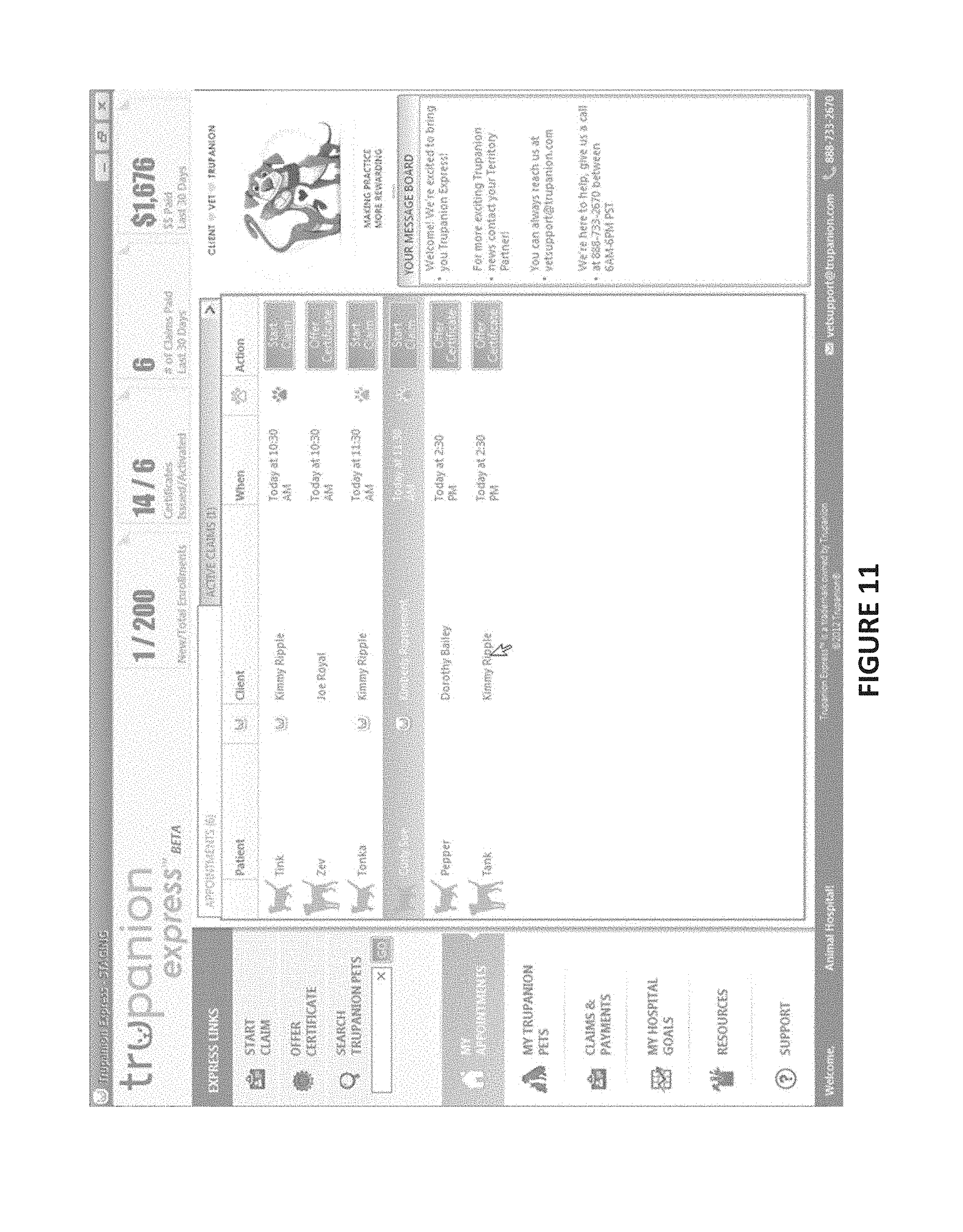
D00013

D00014

D00015

XML
uspto.report is an independent third-party trademark research tool that is not affiliated, endorsed, or sponsored by the United States Patent and Trademark Office (USPTO) or any other governmental organization. The information provided by uspto.report is based on publicly available data at the time of writing and is intended for informational purposes only.
While we strive to provide accurate and up-to-date information, we do not guarantee the accuracy, completeness, reliability, or suitability of the information displayed on this site. The use of this site is at your own risk. Any reliance you place on such information is therefore strictly at your own risk.
All official trademark data, including owner information, should be verified by visiting the official USPTO website at www.uspto.gov. This site is not intended to replace professional legal advice and should not be used as a substitute for consulting with a legal professional who is knowledgeable about trademark law.